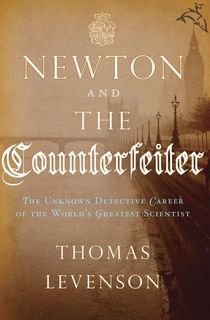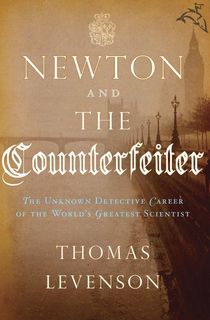Everyone has heard of Sir Isaac Newton. Considered one of the most influential scientists of all time, he was a key figure in the scientific revolution—contributing his ideas as a physicist, astronomer, philosopher, and more. Though best known for his laws of motion and universal gravitation, there's even more to this brilliant man than his scientific contributions.
But did you know that Newton was also a detective? In 1695, after he was already a well-known and influential scientist, Newton made a sudden career change and accepted the position of Warden of His Majesty’s Mint.
At the same time, William Chaloner, an expert counterfeiter, was robbing London blind. Newly appointed warden Newton was tasked with putting an end to Chaloner’s rampage. In Newton and the Counterfeiter, author Thomas Levenson takes readers through this game of cat and mouse between the counterfeiting mastermind and one of history’s greatest scientists. This is Newton like you’ve never seen him before.
For all the praise, honor, and wealth Newton’s performance at the Mint earned him, there was one aspect of the Warden’s work about which no one seems to have warned him before he accepted the post. By ancient practice, the Warden served as the Mint’s only official magistrate, responsible for enforcing the King’s law in and around London for all crimes committed against the currency.
Newton had no interest in the task, and he did his best to shirk it during his first summer at the Mint. He complained bitterly about the work to his superiors at the Treasury: “I am exposed to the calumnies of as many Coyners & Newgate Sollictors as I examine.” A newly instituted reward granted forty pounds for each conviction of a coiner, along with a possible share in the convicted counterfeiter’s confiscated property. Juries understood what such incentives could evoke and had become “so averse from believing witnesses,” Newton noted, “that my agents and Witnesses are discouraged & tired out . . . by the reproach of prosecuting and swearing for money.” Simply asking him to do the work at all was unfair: “I do not find that prosecuting of Coyners was imposed upon any of my Predecessors.” Hence, he concluded, “I humbly pray that this duty may not bee annexed to the Office of the Warden of his Majts. Mint.”
His prayers were denied. On July 30, 1696, the Treasury gave him the bad news. There would be no escape from his duty, and he was to start right then, with the vexing case of the disappearance of a set of coining dies from inside the Mint.”
“Nothing in Newton’s prior career would seem to have prepared him for the sheer muddle of a criminal inquiry. Curves had properties that could be analyzed and relationships that could be proved. The behavior of bodies in motion could be observed and mapped against mathematical predictions. Theological argument could return to ancient texts, and rested always on the truth that God existed and acted in the world. To be sure, no one knew better than Newton how to shape a chain of cause and effect until only one possible conclusion remained. But here, there was no reliable measure with which to penetrate a maze of conflicting, chaotically human accounts. But he had no choice: the new Warden had to turn himself into a detective able to penetrate such confusion. Newton’s law enforcement career began with a simple question: what, in fact, had happened to the tools from the Mint?
No one could quite say.
It was possible to see how the affair began—or rather, first became known to the authorities. One day early in the year, Charles Montague, Chancellor of the Exchequer, found in his office a petition to the King and his Privy Council, dated January 13, 1696, and signed by a suspected felon confined at Newgate Jail, William Chaloner. Chaloner blamed his current predicament on the testimony he had given to the councilors the previous summer of wild abuses at the Mint. Mint officers had responded to the accusations by arranging with a private thief-taker to round up some of their usual coining suspects to testify against Chaloner, and had managed to get him committed to the cells pending the proper stitching up of the case that should have put a full stop to his career.
Despite this history, Montague does not appear to have fully grasped the significance of the signature on the petition he held in his hand. He may have recalled that someone by that name had been rewarded for his role in the discovery of Jacobite printers back in 1693. He probably did not remember, if he ever knew, that Chaloner had been held for coining at least once before, winning escape before trial when his accuser was put to death. Even if Montague could call that episode to mind, Chaloner’s petition contained such a shocking, eminently plausible description of a conspiracy at the Royal Mint that Montague could not ignore the document. With the Great Recoinage just beginning, any hint of scandal could destroy whatever remained of public faith in the Treasury, so the Chancellor had no choice but to order an immediate investigation into Chaloner’s claims.

Portrait of Newton by Godfrey Kneller.
Photo Credit: WikipediaChaloner was duly released from Newgate. He returned to Whitehall on May 16, 1696. There, an investigative committee of the Lords Justices of Appeal heard him tell a harrowing story of official corruption and greed. In this sequel to his testimony of the year before, he repeated the claims of his petition: mint moneyers, the men entrusted to make true coins for England, were instead committing crime after crime. Using smuggled blanks made of base metal, they were producing counterfeit guineas on their own. When they did use properly pure silver or gold, they cheated the Mint and the nation by short-weighting the coinage. Worst of all, Chaloner testified, it was the Mint’s own chief engraver who had sold off the official dies—the tools that struck the design into the faces of new coins—to coiners beyond the Tower’s walls. Chaloner named names and swore that “he himself never made a Guinea in his Life,” but he listed both his old confederate Patrick Coffee and, with marvelous bravado, a Mr. Chandler—a name known in the right sort of circles as the coining pseudonym of William Chaloner.
That was one story—horrifying enough to account for Montague’s urgent reaction to the original letter. But was it true? Confounding the investigation, the tale was challenged on the spot by one Peter Cooke, described in his arrest record as “a gentleman,” although he was already known to the authorities and presently residing in Newgate, where he was struggling to escape the death penalty in an unrelated counterfeiting case. With that incentive, he needed to be as persuasive as possible in his testimony, and the story he told the Lords Justices certainly captured their attention. Cooke admitted that he knew about the missing dies. But, he swore, those dies had not been corruptly sold out of the Mint. Rather, they had been stolen in a theft organized by a gang that included Chaloner himself.
Two incompatible accounts were bad enough. But then the Lords Justices heard from Thomas White, no gentleman, but like Cooke a convicted counterfeiter, testifying in the shadow of the gallows. According to White, the Mint itself and at least nal letter. But was it true? Confounding the investigation, the tale was challenged on the spot by one Peter Cooke, described in his arrest record as “a gentleman,” although he was already known to the authorities and presently residing in Newgate, where he was struggling to escape the death penalty in an unrelated counterfeiting case. With that incentive, he needed to be as persuasive as possible in his testimony, and the story he told the Lords Justices certainly captured their attention. Cooke admitted that he knew about the missing dies. But, he swore, those dies had not been corruptly sold out of the Mint. Rather, they had been stolen in a theft organized by a gang that included Chaloner himself.
Two incompatible accounts were bad enough. But then the Lords Justices heard from Thomas White, no gentleman, but like Cooke a convicted counterfeiter, testifying in the shadow of the gallows. According to White, the Mint itself and at least some of those who worked there had indeed conspired in what was growing into a massive counterfeiting scheme. White named a specific employee, a moneyer’s man named Hunter, as the source of official dies sold to coiners. So far, it was a clear, straightforward story—until White added that Hunter had sold one set of dies to William Chaloner.
The swamp into which the inquiry had wandered grew soggier still when a Mint engraver known as Scotch Robin appeared before the committee. Robin corroborated Cooke’s claim that the dies had been stolen, not sold. But the culprit he implicated was not Chaloner but Chaloner’s accuser, Thomas White. When Robin himself came under suspicion, he ran, making his way to Scotland, safely beyond the reach of English writs.
Here the investigators seem to have given up. In this tangle of conflicting stories, only one fact could be stated with any certainty: someone, somehow, had gained illegal access to official coining apparatus. Beyond that, the mystery of the missing dies had become not so much a criminal conspiracy as a circular firing squad, with the growing army of the accused tumbling over themselves in their haste to betray one another.
Into the middle of this mess, under compulsion, came Isaac Newton. He did not yet have any real knowledge about how to run a criminal investigation. He would prove an able student.
Want to keep reading? Download Newton and the Counterfeiter today!
This post originally appeared on The Archive and is sponsored by Open Road Media. Thank you for supporting our partners, who make it possible for Murder & Mayhem to continue publishing the history stories you love.
Featured photo: Wikimedia Commons


